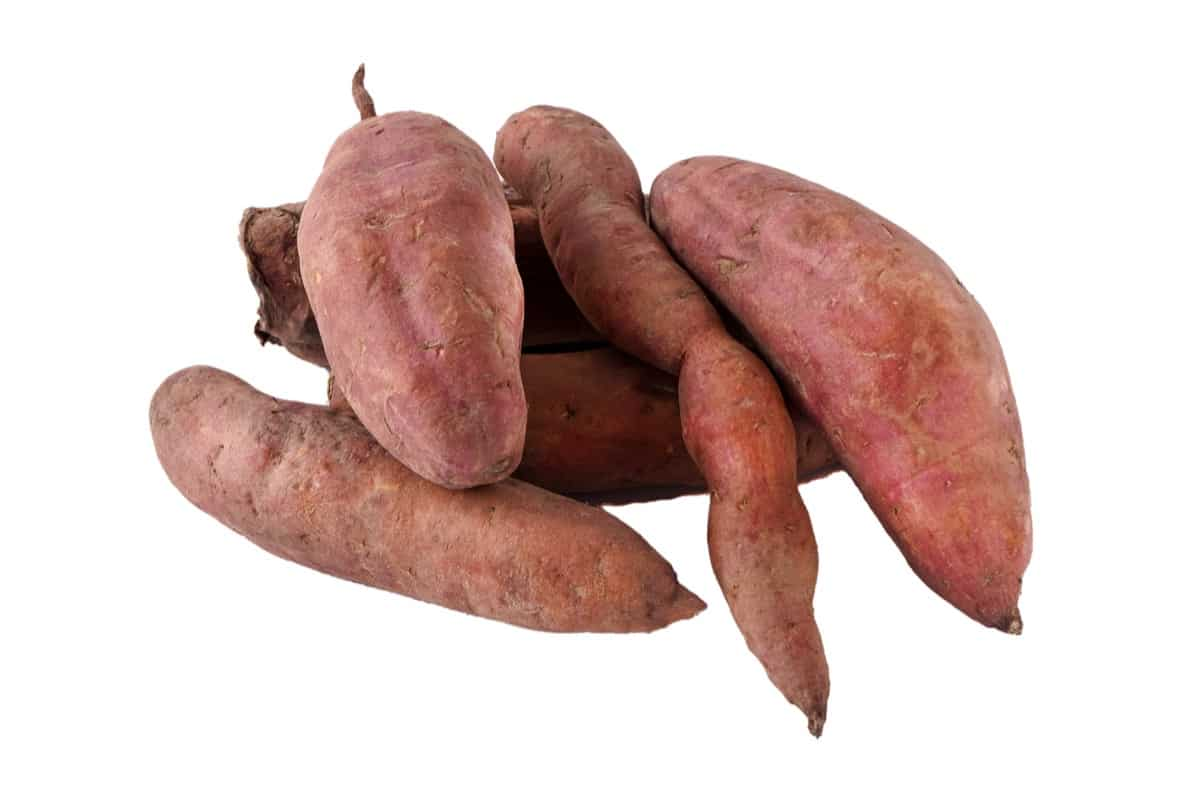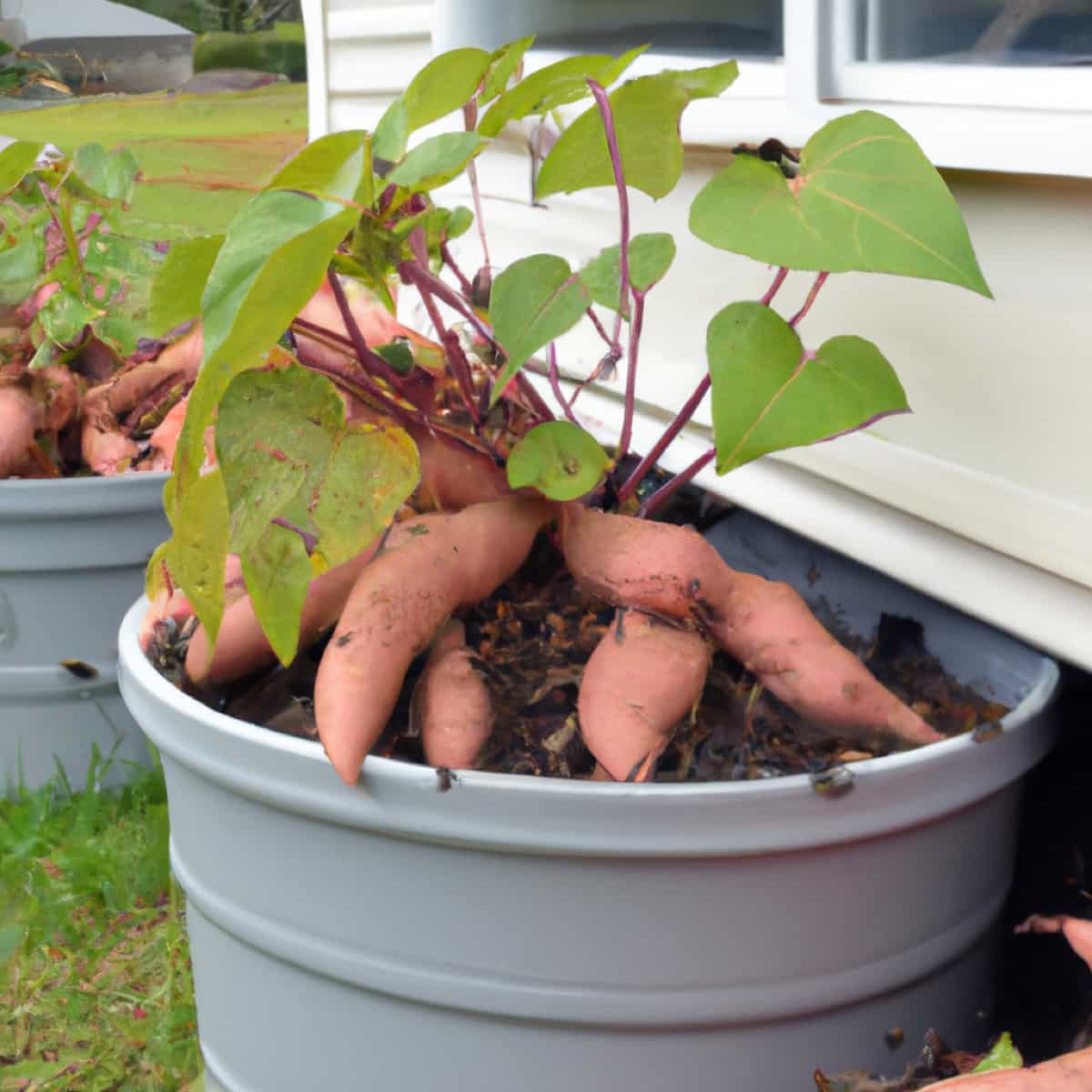Container growing offers flexibility for those with limited space or challenging soil conditions. Whether you’re a seasoned gardener looking to expand your crop selection or just starting your green thumb journey, growing Sweet Potatoes in containers is an excellent choice. Sweet Potatoes are delicious and surprisingly easy to grow in containers. Whether you have limited space or want to try something new, container growing is the perfect solution. You can start from scratch and cultivate your container-grown Sweet Potatoes with a few simple steps.

Container Growing Sweet Potatoes
Best Container Size for Growing Sweet Potatoes
Choosing the right container size is crucial for successfully growing Sweet Potatoes in containers. The container’s size will directly impact your plants’ growth and yield. Ideally, you should opt for a deep container that allows enough room for Sweet Potato vines to flourish. A 20-gallon container or larger would be suitable, as it provides ample space for root development and prevents overcrowding.
Remember that Sweet Potatoes are vining plants that spread horizontally rather than vertically. Therefore, a wider container is more beneficial than a tall one. Additionally, ensure that your chosen container has adequate drainage holes.
Choosing the Right Soil for Sweet Potato Container Gardening
Choosing the right soil is crucial for successful Sweet Potato container gardening. Sweet Potatoes thrive in loose, well-draining soil rich in organic matter. A good potting mix for Sweet Potatoes should include peat moss, perlite or vermiculite, and compost. Peat moss helps retain moisture while also providing aeration to the roots.
Perlite or vermiculite improves drainage and prevents the soil from becoming compacted. Compost adds nutrients to the soil and promotes healthy root development. Avoid using heavy clay soils as they can hinder root growth and lead to waterlogged conditions. Additionally, sandy soils may dry out too quickly and need to hold more moisture for optimal growth.
Watering Requirements for Container-grown Sweet Potatoes
Watering is a crucial aspect of container gardening, and it plays an important role in the success of growing Sweet Potatoes. Sweet Potatoes require consistent moisture throughout their growth cycle, but overwatering can lead to rotting tubers. Ensure that your container has drainage holes at the bottom. This prevents waterlogging and promotes healthy root development.
Sweet Potato plants need regular watering, especially during dry spells or hot weather conditions. However, avoid keeping the soil constantly wet, as this can cause root rot. To determine when to water your Sweet Potato containers, check the moisture level by inserting a finger into the soil. If it feels dry at this depth, it’s time for watering.
Ideal Temperature and Sunlight Conditions for Growing Sweet Potatoes in Containers
Temperature and sunlight play crucial roles in the successful growth of Sweet Potatoes when cultivated in containers. These plants thrive best in warm climates, with temperatures ranging between 21 to 30°C during the day. Choosing a more tolerant variety is essential if you live in a region with cooler or fluctuating temperatures.
When it comes to sunlight, Sweet Potato plants require at least six hours of direct sunlight each day. However, they can tolerate partial shade as well. It’s important to position your containers where they receive maximum sun exposure throughout the day. To ensure optimal temperature and light levels for your container-grown Sweet Potatoes, consider placing them near a south-facing wall or on a sunny patio or balcony. This will help maximize their access to sunlight while protecting them from strong winds.
Selecting the Best Sweet Potato Varieties for Container Gardening
Selecting the right Sweet Potato varieties for container gardening is crucial to ensure a successful harvest. One popular variety is the Beauregard Sweet Potato. Known for its high yield and delicious flavor, this variety is the best choice for container growing. Its compact vines make it ideal for smaller spaces while producing a bountiful harvest.
Another great option is the Porto Rico Sweet Potato. This variety has a shorter growing season than others, making it perfect for gardeners in cooler climates or quicker results. The tubers have a reddish-orange flesh that tastes exceptionally sweet when cooked.
Fertilizing Techniques for Container-grown Sweet Potatoes
Regarding fertilizing techniques for container-grown Sweet Potatoes, there are a few key factors to consider. First and foremost, choosing the right type of fertilizer is essential. To ensure proper nutrient absorption, it’s best to apply the fertilizer in small doses throughout the growing season rather than all at once. Start by applying a quarter-strength solution every two weeks during the early stages of growth.
As the plants mature, they gradually increase the strength and frequency of fertilization. Another important aspect is ensuring that your containers have good drainage so that excess water doesn’t lead to nutrient leaching. Additionally, consider incorporating organic matter into your potting soil mix before planting, as this can help improve fertility over time.
Preventing Pests and Diseases in Sweet Potato Container Gardens
Keeping pests and diseases at bay is crucial for the success of your Sweet Potato container garden. Make sure to start with healthy seed potatoes. Inspect them thoroughly before planting to ensure they are free from any signs of disease or damage. Select certified disease-free varieties whenever possible.
In case you missed it: Backyard Sweet Potatoes: Growing From Scratch for Planting to Harvesting

Next, practice good sanitation by regularly cleaning your containers and tools. Remove any dead leaves or plant debris promptly to prevent the buildup of potential breeding grounds for pests and pathogens. Use natural insect repellents such as insecticidal soap to deter pests like aphids, spider mites, or flea beetles. These organic solutions can help keep unwanted critters away without harming beneficial insects.
Another effective method is companion planting – interplanting marigolds or mint around your Sweet Potato vines can repel insects naturally due to their strong scent. Additionally, proper watering practices play a significant role in preventing fungal diseases like powdery mildew. Avoid overhead watering and instead water directly at the base of the plants to minimize moisture on foliage.
Harvesting Sweet Potatoes Grown in Containers
Harvesting Sweet Potatoes grown in containers is an exciting and rewarding experience. When the leaves start turning yellow and dying back, it’s a good indicator that the tubers are reaching maturity. Before harvesting, stopping watering your plants for about two weeks is important. This will help the Sweet Potatoes develop thicker skin and improve their storage quality.
When you’re finally ready to harvest, gently dig around the base of each plant with a garden fork or shovel. Be careful not to damage or cut into any tubers while doing so. Once you’ve unearthed all your Sweet Potatoes, brush off any excess soil and let them cure in a warm, dry place for about ten days.
Common Mistakes to Avoid When Growing Sweet Potatoes in Containers
One common mistake is using low-quality or heavy soil for planting Sweet Potatoes in containers. Opt for a lightweight potting mix containing organic matter, providing essential nutrients and improving drainage. Finding the right balance when watering can be tricky with container-grown Sweet Potatoes. Overwatering can drown the plants, while underwatering can stunt their growth and yield. Monitor moisture levels regularly and adjust watering accordingly.
Sweet Potatoes thrive in full sunlight, so placing your containers in shady areas will result in weak vines and smaller tubers. Ensure your containers receive at least six hours of direct sunlight each day. Neglecting fertilization can hinder the growth of Sweet Potato plants and reduce their productivity. Use slow-release organic fertilizers specifically formulated for vegetables throughout the growing season according to package instructions.
In case you missed it: 7 Common Problems with Sweet Potato Plants: Treatment and Solutions

Conclusion
Container-growing Sweet Potatoes can be a rewarding and enjoyable gardening experience. You can grow your Sweet Potatoes at home with the right container size, potting soil mix, watering routine, temperature and sunlight conditions, Sweet Potato varieties, fertilizing techniques, pest prevention strategies, and harvesting methods.
- Feed Your Flock for Less: Top 10 Tips to Save on Chicken Feed
- Ultimate Guide to Ossabaw Island Hog: Breeding, Raising, Diet, and Care
- Hatching Answers: The Top 10 Reasons Your Chickens Aren’t Laying Eggs
- Eggs and Economics: Breaking Down the Cost of Raising Backyard Chickens
- Defend Your Greens: Proven Methods to Keep Iguanas Out of Your Garden
- Ultimate Guide to Cinnamon Queen Chicken: A Comprehensive Guide for Beginners
- Ultimate Guide to California Tan Chicken: Breeding, Raising, Diet, Egg-Production and Care
- Ultimate Guide to Marsh Daisy Chicken: Breeding, Raising, Diet, and Care
- 10 Types of Chicken Farming Businesses You Can Start for Profits